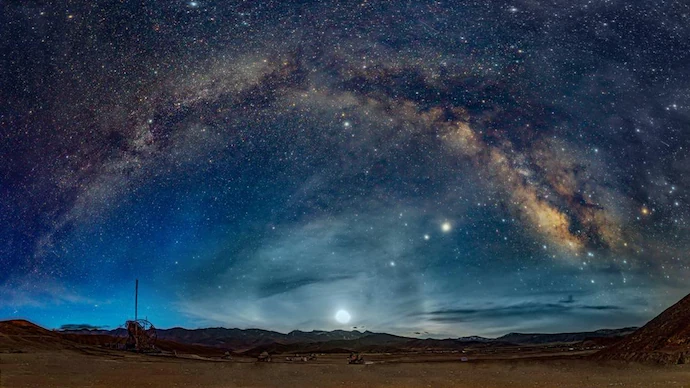Unique Dark Sky Reserve In Ladakh
Unique Dark Sky Reserve In Ladakh. The Dark Sky Reserve is coming in a 22 kilometer radius around Hanle, a cluster of five villages about 300 kilometers off Ladakh. Dark Sky Reserve aims to lower light pollution in the region. The Dark Sky Reserve is located at Hanle, which is about 300 km from Ladakh. A total of 24 astro ambassadors have been selected.
Months after plans were announced to launch a unique initiative to boost astro tourism, Ladakh is ready to get the first Dark Sky Reserve of the country. Radha Krishna Mathur, the Lieutenant Governor of Ladakh, will virtually inaugurate the facility on October 31.
The initiative by the Ladakh Autonomous Hill Development Council (LAHDC), the Union Territory administration, and the Indian Institute of Astrophysics, Bengaluru. They are aiming to lower light pollution in the region for better observations and to boost the local economy by harnessing the power of astronomy.
WHAT IS DARK SKY RESERVE?
It is part of the Changthang Wildlife Sanctuary. As part of the initiative, 24 astro ambassadors have been selected from a cluster of five villages in and around the Indian Astronomical Observatory (IAO).
Funded by the LAHDC, the astro ambassadors will be provided with 8-inch Dobsonian telescopes that will be used to look out into the universe and provide a new avenue of income. The ambassadors will cater to tourists visiting Hanle in hopes of catching a glimpse of the Milky Way galaxy, which shines through the night in the region due to its cloudless skies and lower atmospheric disturbance.
HOW Could IT Start?
The idea of the Dark Sky Reserve was floated by the Indian Astronomical Observatory. A tripartite MoU was signed among the Ladakh Autonomous Hill Development Council Leh, and the Indian Institute of Astrophysics , Bengaluru.
“All the observatories around the world are protected by dark sky policy, which ensures little to no light pollution. Now that more and more people are coming to see the stars and the galaxy in Hanle, it led us to think of protecting our natural and celestial heritage. This has to be done at the village level and if the villages get benefits from this initiative, then why not. Along with villagers, LAHDC and UT Ladakh gave this proposal to set up the reserve,” Dorje Angchuk, Engineer In-charge of IAO, Hanle said.
24 Astro ambassadors selected
A total of 24 astro ambassadors have been selected out of over 70 applications received for the opportunity. They have been trained in handling telescopes and identifying objects, stars and different patterns in the sky. The ambassadors have gone through workshops with IAO and astronomers from IIA Bengaluru.
About 70 per cent of the applications received for the post of astro ambassador came from girls. Out of which 24 finally selected, just 7 are boys.
With the virtual inauguration on October 31, the ambassadors are also being trained in avoiding light pollution. And have been provided with special curtains to lower light pollution. After getting hands-on experience with telescopes, the astro ambassadors are also interested in getting trained in astrophotography.
“We have been trained in using the telescope and we were taught how to tackle light pollution. 18 ambassadors are set to get the telescope and the remaining will get it next year. We will set up the telescope on homestays and show the tourists different stars and the Milky Way,” Rangdol Dorje, an astro ambassador.
With low aerosol content in the air, the high beams can travel up to 10 kilometers in the air. It can affect observations in night. Therefore delineators are also being placed on roads in order to reduce street light dependency. And to make sure tourists coming to the region are not traveling with high beams.
HOMESTAYS AND MILKY WAY ABODE
Located on the wetlands of the Changthang Plateau. It is aimed at boosting the local economy and the results are already visible. Several homestays have come up in the cluster of villages around the observatory. Which are aimed at catering astro tourists, who are visiting Hanle to get a glimpse of the universe.
The astro ambassadors will charge tourists to use the telescope and observe the universe. However, the amount is yet to be decided and discussions are set to happen about it in the coming weeks.
The dark sky reserve is an answer to China’s Dark Sky Reserve that came up in 2016. The facility was launched in the Tibetan prefecture of Ngari, bordering Nepal and India.



